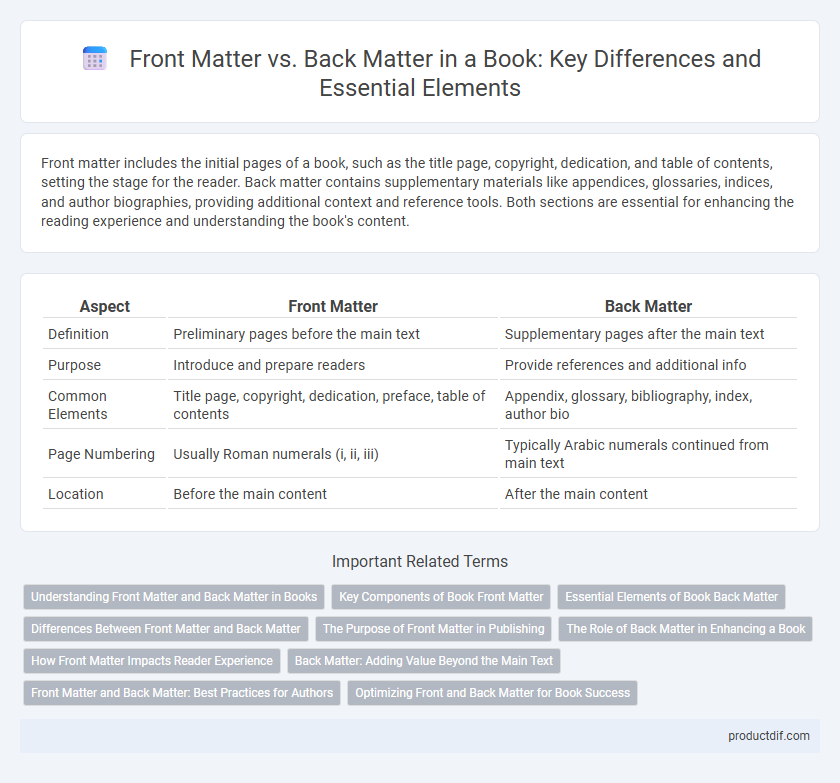Front matter includes the initial pages of a book, such as the title page, copyright, dedication, and table of contents, setting the stage for the reader. Back matter contains supplementary materials like appendices, glossaries, indices, and author biographies, providing additional context and reference tools. Both sections are essential for enhancing the reading experience and understanding the book's content.
Table of Comparison
| Aspect | Front Matter | Back Matter |
|---|---|---|
| Definition | Preliminary pages before the main text | Supplementary pages after the main text |
| Purpose | Introduce and prepare readers | Provide references and additional info |
| Common Elements | Title page, copyright, dedication, preface, table of contents | Appendix, glossary, bibliography, index, author bio |
| Page Numbering | Usually Roman numerals (i, ii, iii) | Typically Arabic numerals continued from main text |
| Location | Before the main content | After the main content |
Understanding Front Matter and Back Matter in Books
Front matter in books includes prefaces, acknowledgments, and the table of contents, providing essential context and guiding readers through the text structure. Back matter contains indexes, glossaries, and bibliographies, offering supplementary information that enhances comprehension and research. Understanding the distinct functions of front matter and back matter improves navigation and enriches the overall reading experience.
Key Components of Book Front Matter
Book front matter includes essential components such as the title page, copyright page, table of contents, foreword, preface, and acknowledgments. These sections provide critical information about the book's authorship, edition, legal details, and guide readers through the structure and purpose of the text. Effective front matter enhances the reader's understanding and sets the tone for the entire publication.
Essential Elements of Book Back Matter
Book back matter includes essential elements such as the glossary, index, bibliography, and appendices that provide additional context and resources for readers. These components enhance comprehension by offering detailed explanations, referenced sources, and supplementary materials that support the main text. Properly structured back matter improves the usability and credibility of a book, making it a critical part of the overall publishing process.
Differences Between Front Matter and Back Matter
Front matter includes introductory elements such as the title page, copyright, dedication, and table of contents, setting the stage for the main text. Back matter contains supplementary materials like appendices, glossaries, indices, and bibliographies that support or elaborate on the content. The primary difference lies in their placement and function: front matter prepares readers and provides essential metadata, while back matter offers additional resources and references after the main narrative.
The Purpose of Front Matter in Publishing
Front matter in publishing serves to orient readers by providing essential information such as the title page, copyright details, acknowledgments, and the table of contents. It establishes the book's credibility, sets the tone, and facilitates navigation, enhancing the overall reading experience. These preliminary pages play a critical role in framing the content and guiding the reader through the structure and context of the book.
The Role of Back Matter in Enhancing a Book
Back matter in a book serves to enrich the reader's understanding by providing supplementary materials such as indexes, glossaries, bibliographies, and appendices. These elements enhance the book's usability and credibility by facilitating easy reference and deeper exploration of the subject. Effective back matter supports academic research, improves reader engagement, and extends the value of the book beyond the main content.
How Front Matter Impacts Reader Experience
Front matter sets the tone for the reader by providing essential information such as the title page, copyright details, acknowledgments, and a compelling preface or introduction that frames the content. This initial section enhances reader engagement by offering context, clarifying the book's purpose, and preparing readers for what to expect, which improves comprehension and retention. A well-organized front matter can establish credibility and create a smoother transition into the main text, significantly impacting the overall reading experience.
Back Matter: Adding Value Beyond the Main Text
Back matter enhances a book's value by providing supplementary content such as appendices, glossaries, indexes, and bibliographies that deepen reader understanding and support research. This section often includes author biographies, acknowledgments, and notes that offer context and credibility, enriching the overall reading experience. Well-organized back matter improves navigation and accessibility, making the book a more useful resource for readers and scholars alike.
Front Matter and Back Matter: Best Practices for Authors
Front matter includes essential components like the title page, copyright information, dedication, and table of contents, setting the tone and providing crucial information for readers. Back matter comprises supplementary elements such as appendices, glossaries, indexes, and author bios, enhancing comprehension and offering additional context. Authors should carefully structure front matter to establish credibility and guide readers, while using back matter to support the main content without disrupting the narrative flow.
Optimizing Front and Back Matter for Book Success
Optimizing front matter, including the title page, copyright information, and engaging foreword, enhances a book's credibility and reader engagement from the start. Back matter elements such as an author biography, appendices, and curated references provide additional value and encourage continued reader interest and further exploration. Strategic use of these sections supports overall book success by improving usability, professionalism, and reader satisfaction.
Front Matter vs Back Matter Infographic

 productdif.com
productdif.com